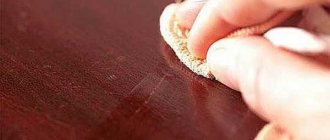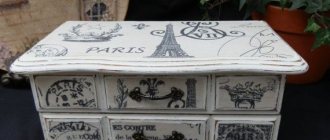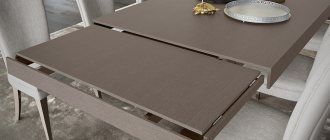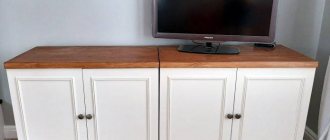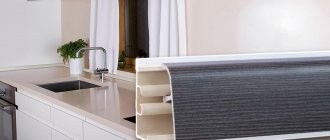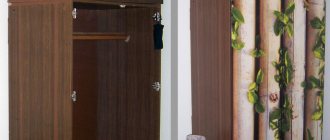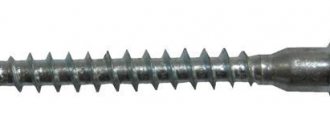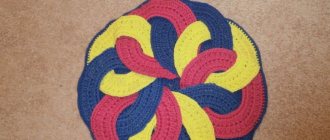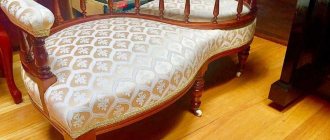If you are tired of your old wooden furniture, which has long lost its presentation, do not rush to throw it away. You can easily restore it to its former shine and beauty. To do this, you don’t need to be a professional restorer and you can easily transform old furniture at home.
This article will talk about removing the old paintwork - this is the first stage of preparing furniture for further transformation and decoration.
You can remove varnish and paint from the surface of wooden furniture by sanding or using special products containing a solvent. Read the details of each method in this material.
How to remove old varnish from furniture with solvent
To remove varnish from furniture at home, you can use a special varnish remover. Such products have high penetrating power and make it easy and quick to clean the surface.
But furniture can be treated with different varnishes on different bases, so it is necessary to choose a solvent that will not harm the furniture and will allow you to achieve results. But you can only remove varnish using solvents from wooden surfaces.
Before removing old varnish from furniture , you need to prepare the wooden surface of the furniture. First of all, it must be cleaned of contaminants. Over the years, a lot of grease and dirt has accumulated on its surface, which must be removed with ordinary soapy water.
Try to clean all the recesses, nooks and panels. Proceed carefully, the wood should not get too wet, and the soap composition should only clean the contaminated surface and not remove the coating from it.
It is better to treat panels and shaped parts of furniture with special solvents to remove old varnish.
There is no point in talking about how to remove varnish from old chipboard furniture, because... this cannot be done. Together with the varnish layer, the decorative layer that replicates this or that texture will be removed or significantly damaged.
Process Features
There are no universal remedies that are suitable in all cases. The choice of the optimal option depends on a variety of nuances. Here are the most important ones.
- Thickness of the previous varnish layer. If it is thick, you will have to spend a significant amount of time removing it.
- Composition of paint and varnish material.
- Surface type. Much will depend on what exactly you have to remove varnish from: parquet flooring or a piece of furniture.
Remove varnish from furniture by sanding
Using sanding, you can not only remove varnish, but also level the surface of wooden furniture. Sanding is done with sandpaper (abrasive) paper manually or using a sanding machine.
To make hand sanding easier, use a simple wooden block and wrap a piece of sandpaper around it.
To remove varnish from furniture , start sanding the surface with medium-grain paper, gradually moving to fine-grain paper.
A special sanding machine of small size and power will greatly simplify the removal of varnish. For such a machine, only fabric-based sandpaper is suitable.
After each sanding step, remove dust from the surface of the object with a slightly damp cotton cloth.
Before removing varnish from furniture , buy a special device with a grip for sandpaper at a hardware store. This will allow you to distribute the sanding pressure evenly.
To sand rounded and convex surfaces, move the sandpaper strip up and down at right angles.
Selecting Tools
To remove nail polish you need the following tools:
- polyethylene film;
- hair dryer, which is used specifically in the construction industry;
- blowtorch;
- hard metal brush;
- soft sponge;
- brush;
- respirator along with a mask for protection;
- a special chemical composition that washes away everything;
- glasses;
- rubber gloves;
- sandpaper;
- sanding paper.
How and how to remove paint from a wooden surface
It is very difficult to completely remove old paint from the surface of furniture, but we will try. For this, special chemical solvents are most often used, which can be purchased at construction or specialized stores, as well as construction hair dryers.
Gently wash the surface of the product with a dishwashing sponge. Instead of a sponge, you can use foam rubber or cotton cloth. Remove soap solution and dirt from the surface of the furniture by wiping it with a soft cotton cloth, first slightly damp, then dry.
First, let's look at how to remove paint from furniture using a solvent and a metal spatula:
- Apply solvent with a synthetic flute brush. Sometimes it is necessary to apply several layers of solvent to remove a thick layer of paint. Follow the time recommended by the manufacturer.
- When the paint softens and begins to peel off the surface of the wood, scrape it off with a metal putty knife.
- Depending on the composition of the old paint and the number of layers, it may be necessary to reapply the solvent to achieve greater softening and swelling of the paint.
Acrylic paints do not adhere to surfaces that have been pre-treated with oil. To remove oil coating, soak steel wool in mineral spirits and rub the surface in a circular motion.
Chemical solvents for removing old paint and varnish are very toxic and require working outdoors or in a well-ventilated area. Then how and how to remove paint from a wooden surface if you do not have the opportunity to take the product to an open place? In this case, use a hair dryer. Working with it is more difficult, but safer for health. Direct a stream of hot air at the old paint and wait for it to swell, then remove the coating with a spatula or scraper.
Cleaning complex contaminants
Folk remedies also help to cope with difficult stains. In particular, to clean surfaces, you can sprinkle problem areas with flour and then wipe with vegetable oil.
Traces from hot dishes
To remove such marks, just put a small amount of salt in a cloth, roll up the bag and wipe the furniture. Then the surface must be treated with vegetable oil.
Wax drops
To get rid of the wax, you need to heat the knife and pry out the drops. After this, the problem area is rubbed with gasoline.
Ink stains
A mixture of beer and wax helps get rid of ink stains. This composition does not need to be boiled first. After treating stains, the mixture should be immediately washed off with water.
Heavy soiling
Heated 9% vinegar can remove such stains. You need to moisten a cotton swab in this liquid and then wipe the problem area.
Cleaning away traces of flies
White wine helps with such traces without adding other ingredients.
Unknown origin
To remove any stains, you can use vegetable oil, which should be mixed with ethyl alcohol.
Fat
Traces of fat can be easily removed with leftover tea leaves wrapped in cotton cloth.
Restore furniture surface: a quick way
Having completed the job of removing old paint from furniture or doors, we often, unfortunately, discover that there is nothing good underneath - just putty and potholed wood. And now there is only more work to do with such a surface before applying new paint!
But you can use a quick way to restore the paint coating. To do this, follow the following instructions:
- To restore the surface of furniture, remove paint only in those places where it has peeled off using a metal spatula.
- Sand the surface of the product covered with old paint using a sanding machine, using first medium-grit sandpaper, then fine-grit sandpaper. Don't try to remove the paint, just smooth it out. If necessary, sand the entire surface of the product using the old paint, leveling and removing defects (for example, smudges and drops of old paint).
- Fill all cleaned areas using wood putty. The drying time for the putty is recommended by the manufacturer.
- After the putty has dried, sand the surface again - manually or using a sander.
- After this, wipe the product from dust and repaint the entire surface in two or three layers.
The surface prepared in this way can be repainted in any color, using the old coating as a primer.
When sanding, be sure to wear a mask to protect you from dust. Only work with chemical solvents outdoors or in a well-ventilated area and be sure to wear rubber gloves. Follow manufacturers' instructions regarding use, storage and disposal of solvent.
If your home is not the Hermitage, and the furniture is just an old shelf or bedside table, use this easy way to restore the paint finish.
What might you need?
You can clean varnished surfaces using:
- soft cloth;
- cotton swabs;
- leather (it is recommended to take soft and thin skin);
- a brush with soft bristles.
To clean polished home furnishings, you will need not only cleaning products, but also a knife to remove serious stains.
Soft flannel or cotton cloth
Flannel and cotton fabric practically do not electrify varnished wood and do not leave streaks. Therefore, it is often recommended to wipe furniture with this material.
Cotton swabs
Cotton wool is used to clean stubborn stains.
Pieces of soft leather
Soft leather is recommended to be used to add shine after cleaning from dirt.
Soft brush
This brush is used to remove stubborn stains. After polishing with such products, no scratches remain.
Water containers
When cleaning furniture, you will need any containers with a wide neck: buckets, pans, or others.
Knife for removing serious stains
The knife is used only in cases where other cleaning methods have failed.
Polishing agents
It is necessary to renew the smooth layer on the surface of the furniture regularly, and after exposure to any cleaning agents, it is imperative.
For this purpose, in addition to industrially produced polishes, you can also use homemade compositions from household substances:
- Burr oil . Plant extract is best suited for polishing furniture without adding additional components. Using a cotton swab soaked in the composition, wipe the entire surface with little effort.
- Vegetable oil with vinegar . This mixture is prepared by mixing the components in equal volumetric proportions. Then apply to polish and rub.
- Beer . A piece of wax or paraffin is added to the beer being heated for cleaning. After cooling, a composition is obtained that can clean off dirt and simultaneously polish the same area.
In more advanced cases, a complex restorative mixture will help. It is prepared by mixing turpentine, linseed oil and vinegar in a volume ratio of 2:2:1. Before use, shake the composition vigorously and apply the resulting emulsion to the area with the damaged varnish layer.
All polishing agents are rubbed in a circular motion. It is not recommended to use sponges and brushes. The best tool is flannel or suede.
Reasons for contamination of polished objects
As with any furniture, the main reason is dust settling on smooth tables, cabinets and bedside tables. But varnished surfaces not treated with antistatic agents have an increased ability to “attract” the smallest particles. Microcracks in the smooth layer also accumulate contaminants, which are difficult to remove. Therefore, the fight against dust on polished furniture is especially important.
Additional causes of pollution are:
- greasy fingerprints left after touching the polish;
- stains from any spilled liquid;
- stains from wet wiping of furniture that were not removed in time by additional polishing;
- stuck pieces of paraffin, wax or plasticine;
- traces from the impact of hot objects placed on the surface without gaskets.
In addition to dust, most pollution is created by one’s own hands as a result of negligence when handling furniture. You can avoid them by following simple rules. But we cannot rule out chance.
If stains do appear on polished furniture, you need to be able to remove them correctly without causing additional harm.
